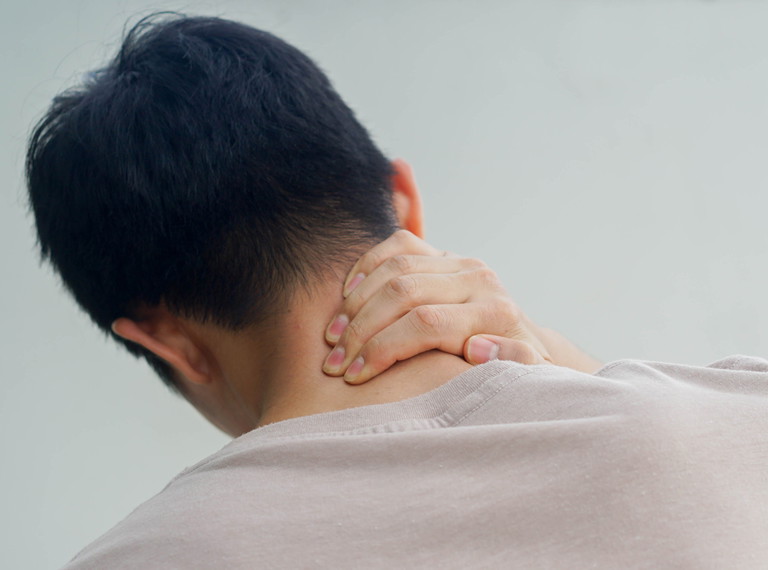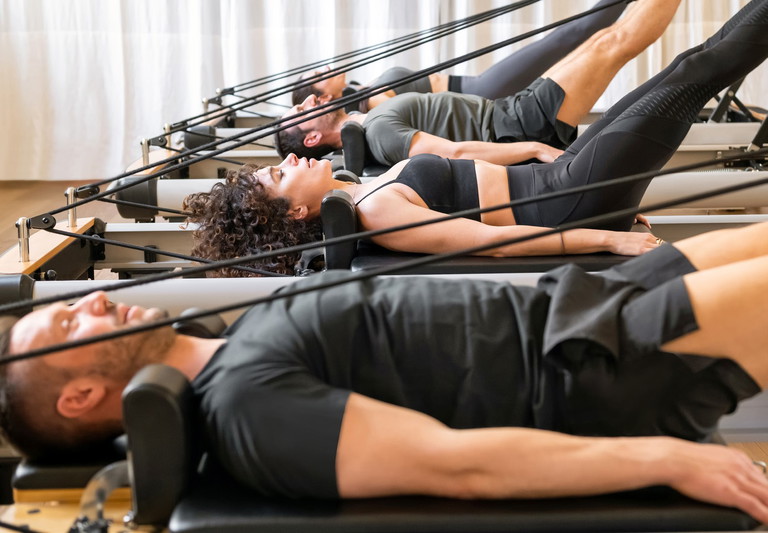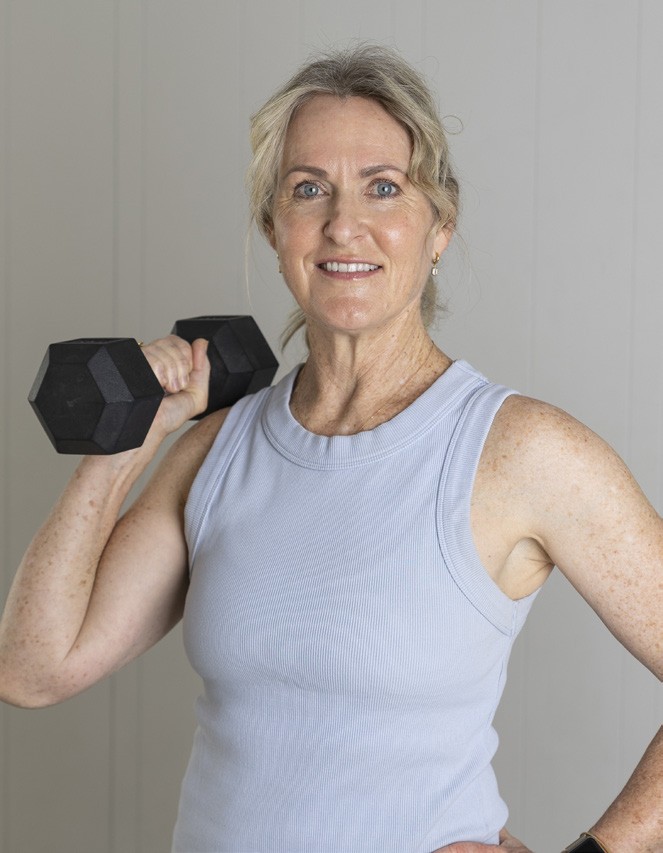mifeature
Improving and Maintaining Physical Health and Wellbeing
Musculoskeletal disorders are pervasive in healthcare, and eye care professionals are no exception. While the focus of ophthalmic practice is on visual health, physical wellbeing remains foundational to sustained clinical performance and career longevity. This article explores key health metrics, identifies modifiable risk factors, and outlines evidence-based interventions to promote musculoskeletal resilience and overall wellbeing.
WRITERS Sarah Ashe and Christine Le

EPIDEMIOLOGY OF MUSCULOSKELETAL DISORDERS IN EYE CARE
The prevalence of musculoskeletal symptoms among eye care professionals is alarmingly high. A recent survey reported:
• 75% experience musculoskeletal tension, pain, or discomfort,
• 60% indicate that symptoms impair their clinical duties,
• 72% report sleep disturbance secondary to these issues, and
• The neck is the most affected area (56%).1
These findings are consistent with broader occupational health data. Office-based healthcare workers have higher rates of musculoskeletal injuries than manual labourers.2 Low back pain (LBP) is the leading cause of disability worldwide, with up to 90% of the population experiencing it in their lifetime. Shoulder pain prevalence, at 70%, mirrors these figures.3
Moreover, 67% of Australians over age 50 present with poor bone health (osteopenia or osteoporosis), and 30% of individuals aged 50–70 have osteoarthritis.4,5 Such statistics underscore the importance of proactive musculoskeletal health strategies.
FUNCTIONAL HEALTH INDICATORS
Two clinically accessible metrics – grip strength and floor-to-stand ability – offer significant insight into an individual’s musculoskeletal and functional status, and whole health and longevity.
Grip Strength
Grip strength is a robust predictor of total body strength, functional status, and mortality.6 A 5 kg reduction in grip strength correlates with a 16% increased risk of all-cause mortality, a 17% higher risk of cardiovascular death, and a 9% increase in stroke risk.7,8 Low grip strength also predicts slower gait, poor balance, increased fall risk, and is associated with cognitive decline and dementia.8-10
Floor-to-Stand Ability
The ability to rise from the floor without assistance reflects lower limb strength, balance, coordination, and overall mobility and confidence. Delays (>10 seconds) in adults are considered an early sign of functional decline. The inability to perform this task in older adults significantly increases fall risk and hospitalisation rates.11,13
CURRENT CHALLENGES IN PAIN MANAGEMENT
Traditional approaches to managing LBP and neck pain have often relied on low-value interventions, including routine imaging, passive modalities, and pharmacologic measures. However, evidence increasingly supports a biopsychosocial (BPS) model of care.
Limitations of Conventional Care
Magnetic resonance imaging (MRI) scanning often leads to increased disability and is poorly correlated with clinical symptoms. ‘Pathology’ is a poor predictor of future pain and disability.14
Radiology does not have weight, without correlating with clinical assessment and findings by a physiotherapist.
Passive treatments offer only short-term relief and promote dependency.15
Opioids are no more effective than nonopioid alternatives and carry significant risk.
Spinal injections and fusions provide limited long-term benefits and are often no better than exercise rehabilitation.16,17
Biopsychosocial Approach
The BPS model addresses the complex interaction of biological, psychological, and social influences on pain.18 Cognitive functional therapy (CFT) integrates these domains and is currently the most evidence-based approach.
Intervention Strategies Biological. Targeted physiotherapy for clinical assessment, diagnosis, and best evidence-based management.
Psychological. Incorporation of mindfulness, clinical Pilates, and exercise to support mental health, or referral to mental health professionals.
Social. Consideration of work demands, familial stressors, sleep quality, and nutrition.
For persistent LBP or neck pain, a multimodal strategy combining reassurance, advice and education, manual therapy, exercise with progressive loading, oral and topical medication, sleep and nutrition strategies, and, where needed, psychological input yields superior outcomes.19
POSTURE AND ERGONOMICS: RETHINKING THE EVIDENCE
Contrary to longstanding assumptions, posture alone is not a direct cause of LBP.20 Postural variability is more important than achieving a so-called ‘ideal’ alignment:
• There is minimal evidence that specific static postures prevent spinal pain.
• Standing desks provide some benefit, but the key lies in movement variability.
• Ergonomic advice should be tailored to the individual’s pain mechanisms and symptom patterns.
This reflects the multidimensional nature of nonspecific LBP (NSLBP) and the need to address biopsychosocial aspects, rather than fixating solely on posture.
The key message: ‘Your best posture is your next posture’.
PREVENTIVE STRATEGIES AND MOVEMENT GUIDELINES
Clinicians often neglect their own physical maintenance, despite the evidence supporting movement as medicine.
Exercise is one of the few interventions that consistently improves health span and reduces morbidity.8 Just as eating a wide range of food is best, a wide range of postures and movement is best. Move more, load more, stretch more, breathe more and you will have more energy, better focus, and reduce your risk of discomfort and disease.
The core components of a preventative routine are breath work, mobility and stability, strength through functional range, balance and proprioception, weightbearing and impact exercise, cardiovascular conditioning, motor control and coordination, and fascia/nerve gliding.
Practical Recommendations
• For every 30 minutes of sitting, include at least two minutes of movement,2
• Sit on the floor periodically to maintain leg mobility, strength, and balance,
• Exercise in positions different from those used during clinical work, (e.g. Pilates, swimming).
• Improve breath mechanics,
• Include 10–15 minutes of daily movement ‘maintenance’,
• Maintain consistency,
• Target whole body strength training at moderate to high intensity at least twice weekly, and
• Target cardio conditioning with at least 150–300 mins of moderate intensity aerobic activity or 75–150 mins of vigorous intensity aerobic activity weekly.21
MOVEMENT PROTOCOLS FOR ECPS
Changing your exercise and movement behaviours can be overwhelming OR EMPOWERING. You have the capacity to change how you feel in your body now and moving forward.
We have devised two movement routines specific to eye care professionals that are simple, doable, and efficient. The first focusses on stability and mobility, the second on strength.
“Clinicians often neglect their own physical maintenance, despite the evidence supporting movement as medicine”

Stability refers to neuromuscular control and the ability to execute movement efficiently through coordinated motor control, proprioception, and joint alignment. All joints rely on stabilising musculature to minimise tensile load, promote joint congruency, and support functional integrity. This concept extends beyond traditional ‘core’ training and is better understood as whole-body control originating from the trunk and transferring through kinetic chains. Optimal stability underpins movement efficiency, functional performance, and injury prevention.22,23
Mobility, in contrast, is the capacity to move actively and freely through joint and tissue ranges. Unlike static stretching, which primarily targets muscle length, mobility training is dynamic and integrative. It addresses the complex interplay of soft tissue extensibility, joint capsule restriction, motor coordination deficits, neurodynamics, and fascial continuity. Effective mobility work restores suppleness and responsiveness to movement-limiting tissues, enhancing both function and performance.24,25
Together, stability and mobility form the foundation of efficient, resilient movement patterns essential for sustained clinical practice and long-term musculoskeletal health.
“Unlike static stretching, which primarily targets muscle length, mobility training is dynamic and integrative”
STABILITY/MOBILITY ROUTINE
The aim is to move slowly, quietly and with control. The less global muscle activity you feel, the better you are performing the exercises.
Diaphragmatic breathing. Influences neuromuscular coordination, organ function, pain perception, fatigue, stress regulation, and mindset.26
• Place two release balls at your thoracolumbar junction and lean into them on the wall or back of a chair,
• Breath into the balls,
• Aim for slow, nasal breath and find all four components of breathing: inhale, pause, exhale, pause.
For more, scan this QR code.

Neck ramping. Improves cervical alignment, decompresses intervertebral discs, lengthens posterior neck musculature, and activates deep neck flexors (DNFs). It is particularly effective for managing neck tension, cervicogenic headaches, and impaired upper limb coordination.
• Sit or stand upright with broad shoulders; relax jaw and tongue.
• Retract the chin by drawing it backward (not downward), tracing a ramp-like path to elongate the cervical spine.
• Initiate movement from C1–C3 to engage DNFs.
• Repeat periodically to relieve neck/shoulder tension and improve motor control.
• To further engage DNFs and offload paraspinal muscles, perform supine with head supported on a towel.
For more, scan this QR code.

Scapular CARS. Enhances scapulothoracic mobility and neuromuscular control, which is key for clinicians performing fine motor tasks under static postural loads.
• Sit or stand upright with relaxed breathing into the mid-thorax.
• With a stable trunk, move the scapula in a controlled circular motion: elevate, retract, depress, protract; avoiding abrupt or segmented movement.
• Perform at pain-free shoulder ranges to optimise scapular control.
• Begin in open-chain; progress to closedchain (quadruped, modified plank, full plank) to increase proprioceptive demand and joint stability.
For more, scan this QR code.

Tandem stance. Improves balance, core stability, and proprioception by narrowing the base of support. The tandem stance activates the postural system, enhances lower limb coordination, and stimulates the vestibular and proprioceptive systems. Integrate this exercise into daily tasks e.g., phone calls, standing desk, or waiting in line.
• Stand heel-to-toe (or as close as safely possible) with even weight across both feet.
• Maintain upright posture: align sternum over pubic bone and breathe into the mid-back.
Progressions:
• Turn head side to side.
• Lift gaze or gently close eyes.
• Reach arms overhead or across the body.
• Pass a weight around hips.
• Add a slow, controlled calf raise.
These variations increase challenge and improve postural adaptability.
For more, scan this QR code.

Cat/cow mobilisation. This dynamic spinal mobilisation promotes segmental movement, activates deep stabilisers, and facilitates neural and fascial glide, which is key for counteracting stiffness and postural fatigue.
• Begin in a quadruped stance with hands under shoulders, knees under hips.
• Establish a long spine and broad shoulder girdle.
• Initiate movement from the pelvis: curl the tailbone, draw the abdomen inward, and sequentially flex the lumbar, thoracic, and cervical spine, chin to chest.
• Reverse the motion with controlled spinal extension, again initiating from the pelvis.
• Focus on small, segmental movements to distribute load evenly and restore mobility in restricted segments. Avoid forcing range.
• Repeat on forearms to increase scapular engagement.
Note: Repetition and frequency should be adapted to individual needs. Integrate regularly throughout the day to maintain spinal pliability and optimise function.27
For more, scan this QR code.

STRENGTH ROUTINE
Strength should not come at the expense of mobility; both are essential for functional resilience. Training should prioritise pain-free (or tolerable) range, slow and controlled execution, and whole-body integration. Emphasis should be placed on myofascial slings and coordinated muscle groups that replicate functional demands.
Begin with low-load exercises to establish movement competency before progressing to heavier resistance. Neuromuscular and structural adaptations to strength training require consistent effort over approximately 12 weeks. Strength through range is preferable to passive stretching for enhancing flexibility and dynamic control.28,29
Strength Routine
Triceps press-up (wall to floor). Targets the often-underutilised posterior arm and scapular stabilisers, key antagonists that support upper limb and spinal function. Despite its simplicity, proper execution requires considerable control and alignment.
• Begin at the wall; progress to floor-based variations,
• Position hands shoulder-width apart at shoulder height with a broad shoulder girdle,
• Inhale while bending elbows close to the torso; exhale while extending the arms,
• Maintain spinal and pelvic alignment throughout,
• Ensure the humeral head remains centred in the glenoid fossa to optimise joint stability,
• Increase difficulty by stepping feet further from the wall, then progressing to quadruped, modified plank, and full plank positions.
For more, scan this QR code.

Short lever shoulder flexion. Highly functional and particularly beneficial in the management of common shoulder pathologies.3
• Sit or stand upright with a broad shoulder girdle,
• Hold a moderate weight in one hand, sufficient to challenge strength without compromising form,
• Maintain a neutral wrist, palm in, bend the elbow, and press the hand overhead within a pain-free or acceptable range,
• Aim for full elbow extension as tolerated,
• Return by bending the elbow, bringing the hand to the shoulder, then lowering under control.
For more, scan this QR code.

Split squats. Develops functional lower limb strength while enhancing balance, core control, and dynamically lengthening the hip flexors.
• Assume a staggered stance with one leg forward,
• Distribute weight evenly between legs; maintain an elongated, upright torso,
• Bend both knees – front knee over ankle, back knee under or slightly behind the hip with the rear heel elevated,
• Increase difficulty by widening the stance and lowering until the back knee lightly contacts the floor,
• Progress by adding weights in one or both hands to increase load through the legs, trunk, and upper limb kinetic chains.
For more, scan this QR code.

“Clinicians must view physical self-care not as optional, but as integral to their capacity to deliver sustained, high-quality care”
Farmer carry. A compound activity that develops grip strength, whole body strength, postural control, and cardiovascular conditioning.2,8 Hold a challenging but manageable weight in each hand.
• Maintain a wide shoulder girdle and avoid scapular depression,
• Engage upper limb and trunk musculature by supporting the weight through the shoulder complex, not just the hands,
• Walk forward with an upright, steady posture for approximately 30 seconds,
• Avoid lateral sway or favouring one side,
• Progress by increasing load or using asymmetrical loading (one hand) to further challenge trunk and balance control.
For more, scan this QR code.

Useful Resources
• Featherstone Physio Pilates: feather-stone.com.au.
• PainHEALTH: painhealth.csse.uwa.edu.au.
• Featherstone On Demand: feather-stone.com.au/featherstone-on-demand.
• Wellbeing area at the RANZCO 25 Melbourne conference tradeshow.
CONCLUSION
Eye care professionals are at high risk of musculoskeletal dysfunction due to the physical and mental demands of clinical work. Proactive and evidence-based strategies including functional health assessment, movement variability, strength training, and a biopsychosocial approach to pain, can significantly reduce disability and enhance professional longevity. Clinicians must view physical self-care not as optional, but as integral to their capacity to deliver sustained, high-quality care.
Sarah Ashe BPhysio (Hons) is the principal physio at Featherstone Physio Pilates. A Polestar Pilates certified practitioner in rehabilitation and GLA:D (Good Life with Arthritis: Denmark) certified, she is also a therapeutic yoga certified practitioner and Polestar Pilates mentor.
Ms Ashe has over 30 years’ experience with arthritis, spinal, and sacroiliac joint pain, chronic pain, multi-trauma, pre and post-op management, neuro rehab, exercise/sports specific rehab, ergonomics, breath therapy, stretch therapy, and fascial ease. She regularly presents at conferences and leads retreats.
Christine Le BPhysio is a senior physiotherapist and pelvic health physiotherapist at Featherstone Physio Pilates. A Polestar Pilates certified practitioner in mat and reformer, she has undertaken further training in deep tissue needling, as well as studio and rehabilitation Pilates, is a Women’s Health Through Life Ready Physio, and is GLA:D certified. Ms Le is currently undertaking the Masters of Clinical Physiotherapy (Musculoskeletal).

Sarah Ashe

Christine Le
References available at mivision.com.au.